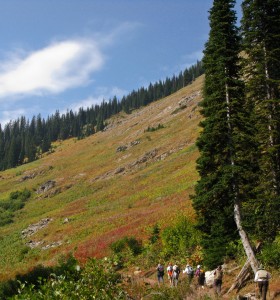 When I was a child, hiking with my parents, we would stop every once in awhile and sit on a rock or downed log at the side of the trail. My father would ask me where in the world I thought I was. Unfolding the bulky topographic map and looking to the hillsides, I tried to match their slopes to the squiggly brown waves of lines on the map.
When I was a child, hiking with my parents, we would stop every once in awhile and sit on a rock or downed log at the side of the trail. My father would ask me where in the world I thought I was. Unfolding the bulky topographic map and looking to the hillsides, I tried to match their slopes to the squiggly brown waves of lines on the map.
I thought about that on our recent hike to Cliff Lake. I had borrowed my husband’s GPS and used it to mark waypoints and plot out our route. I knew exactly where I was at every step–at least within a few dozen feet. Aided by 7 satellites, my progress was recorded on the little screen that told me my direction, my altitude, the distance to the lake, the distance we had come and what my hiking pace was. It even told me how long it would be until the sun set. The one thing it didn’t inform me of was the giant mud puddle in the trail, which I walked right into, my eyes affixed to the little screen.
That managed to break the GPS’ spell. I thought back to those pre-GPS times when you had to look around you instead. Gene shared the trick of using your analog watch (yes, we old timers still wear watches with hands) to tell where south is. Holding up your wrist and aligning the small hand with the sun, you could find south halfway between the hour hand and the minute hand. A map could give us good idea of altitude, but knowing that we were walking through a forest of subalpine fir gives us a rough approximation and finding treeline on the hillsides around the lake told us we were nearly 6,000 feet high.
Those watches came in handy again, by telling us how long it had been since we left the trailhead. Years of hiking means we know we have a pace of about 20 minute miles–longer if we are going up steep paths or taking pictures or stopping to discuss the identity of wildflowers. Shorter if we are a long ways from the trailhead in the late afternoon and we’re hungry or going downhill. And having the map in our memory will tell us at what part of the trail the creeks must be crossed. Simply listening for water will tell us how close we are to that crossing.
As for the sunset, my father taught me how to tell when it would slip behind the peaks and the air would chill. Holding your hand out at arms length, the fingers horizontal, you place your pointer finger parallel to the ridge line and count the number of fingers between that and the bottom of the sun. Each finger equals 15 minutes.
I think, when my father asked me where in the world I was, he was not asking for the co-ordinates of my position on the map, he was asking me how deeply conscious I was of the world around me. It is not a question that can be answered by a GPS.
